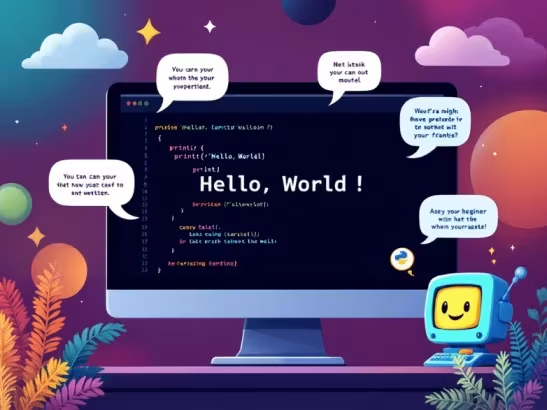Hey there, newbie programmers! Have you ever heard of “Hello World”? It’s like the first program that every beginner writes when they start learning a new programming language. It’s just a simple program that prints the words “Hello World” on the screen. But don’t let that fool you – it’s actually a great way to learn the basics of programming.
When you write your first program in Python, you’ll need to use the print() function. It’s like a magic spell that tells Python to display something on the screen. Here’s how you do it:
print("Hello World")See that? That’s all there is to it! As soon as you run that code, you’ll see “Hello World” pop up on your screen. It’s a great way to get a feel for Python and see how it works.
But before you can start writing your own programs, you need to make sure you have Python installed on your computer. It’s like having a special toolkit that you need to use to build your programming skills. You can download Python from the official website (https://www.python.org/) and follow the instructions to install it on your computer.
Here’s how you can download and use Python:
**Downloading Python:**
1. Go to the official Python website at python.org.
2. Look for the downloads section and choose the version that works with your operating system (Windows, macOS, or Linux). It’s best to get the latest stable version.
**Installing Python:**
1. Run the downloaded installer.
2. When installing, make sure to check the box that says “Add Python to PATH.” This way, you can easily run Python commands from the command line.
**Verifying Installation:**
1. Open your command prompt (CMD on Windows, Terminal on macOS/Linux).
2. Type python –version or python –version (which means python double dash version). This should show you the version of Python you installed. If it works, you’re all set!
**Using IDLE to Run Your Code:**
Python comes with a special program called IDLE that’s great for beginners. Here’s how you can use it:
1. After you install Python, open your applications menu and find IDLE. It’s usually the Python program.
2. Now you can start coding!
Click to open.
**Creating a New File:**
Once you’ve opened IDLE, you can start writing your code. Go to the ‘File’ menu and select ‘New File’. This opens a new window where you can write Python scripts.
**Writing Your Code:**
In the new file, type the following code:
print(“Hello World”)Save the file with a ‘.py’ extension (for example, ‘hello.py’).
**Running Your Code:**
To execute your code, go back to the IDLE menu, select ‘Run’, and then ‘Run Module’. Alternatively, you can press ‘F5’. The output will appear in the Python Shell window.
**The Importance of ‘Hello World’:**
Learning to code ‘Hello World’ is more than just a rite of passage for programming novices; it solidifies the understanding that programming languages are tools to communicate instructions to a computer.
By starting with a ‘Hello World’ program, learners practice fundamental coding skills, such as syntax and output, and begin cultivating a mindset essential for problem-solving in programming. This simple phrase opens the doorway to more complex concepts, encouraging experimentation and curiosity that fuels a programmer’s journey. Starting small allows learners to conquer the initial hurdle, setting the stage for tackling more intricate programming tasks with confidence.


